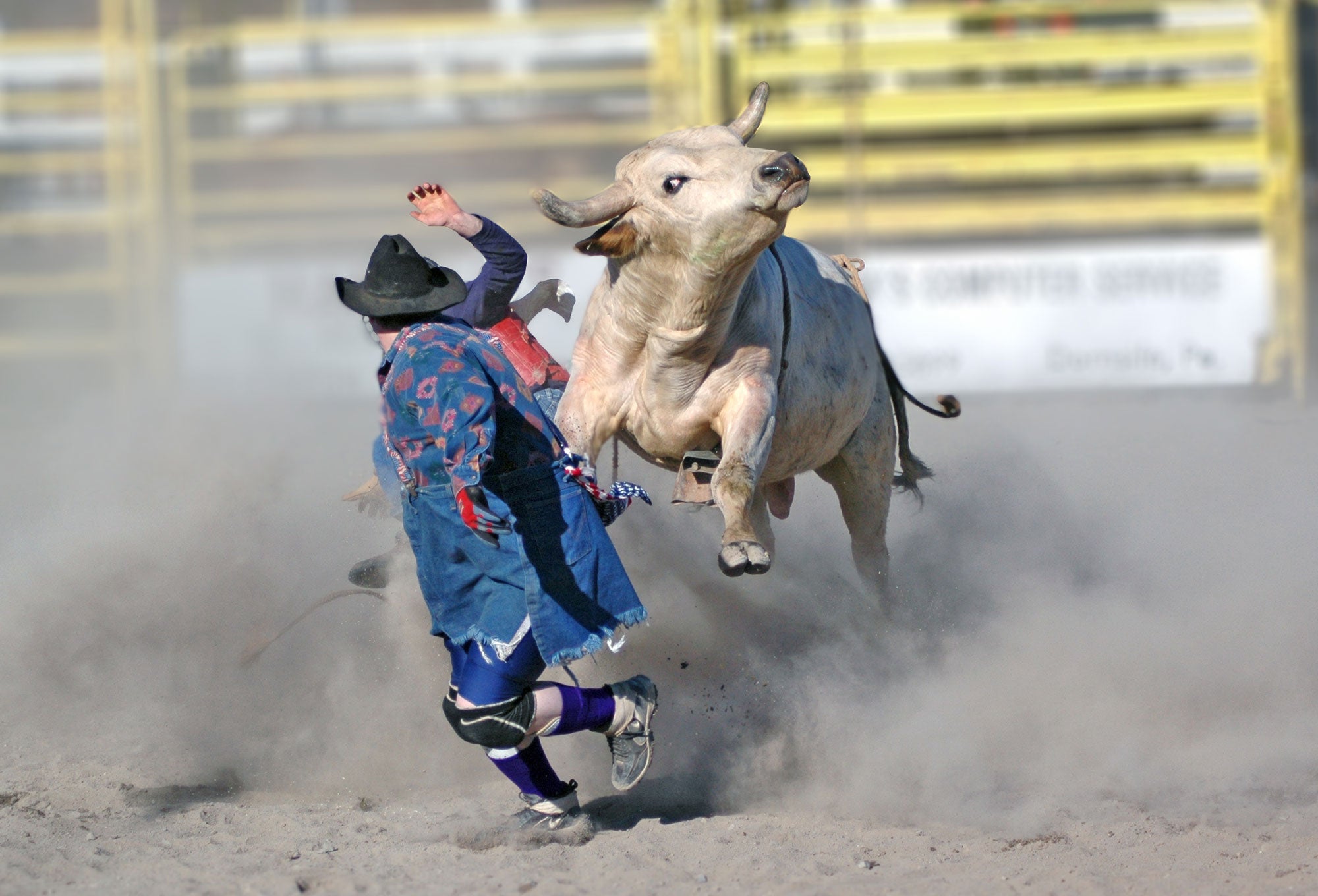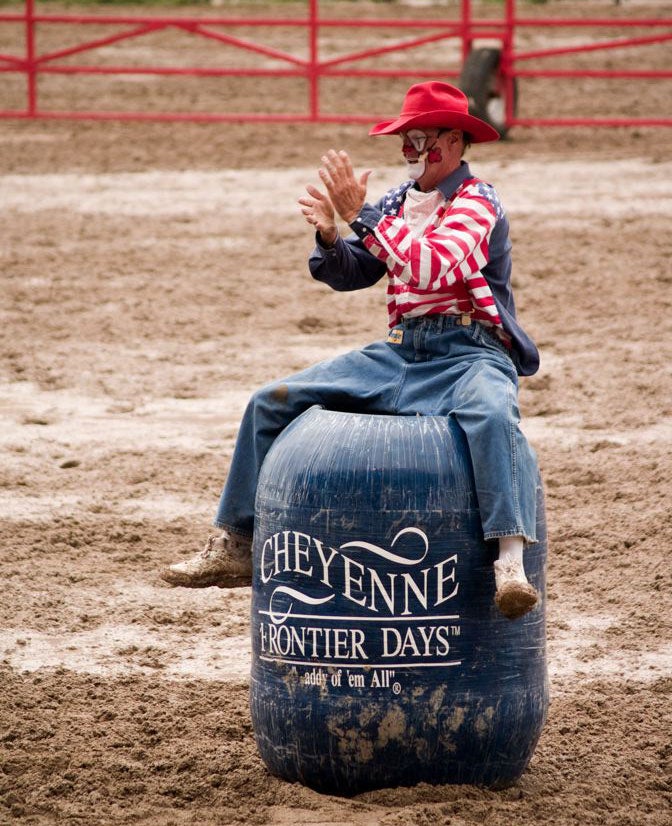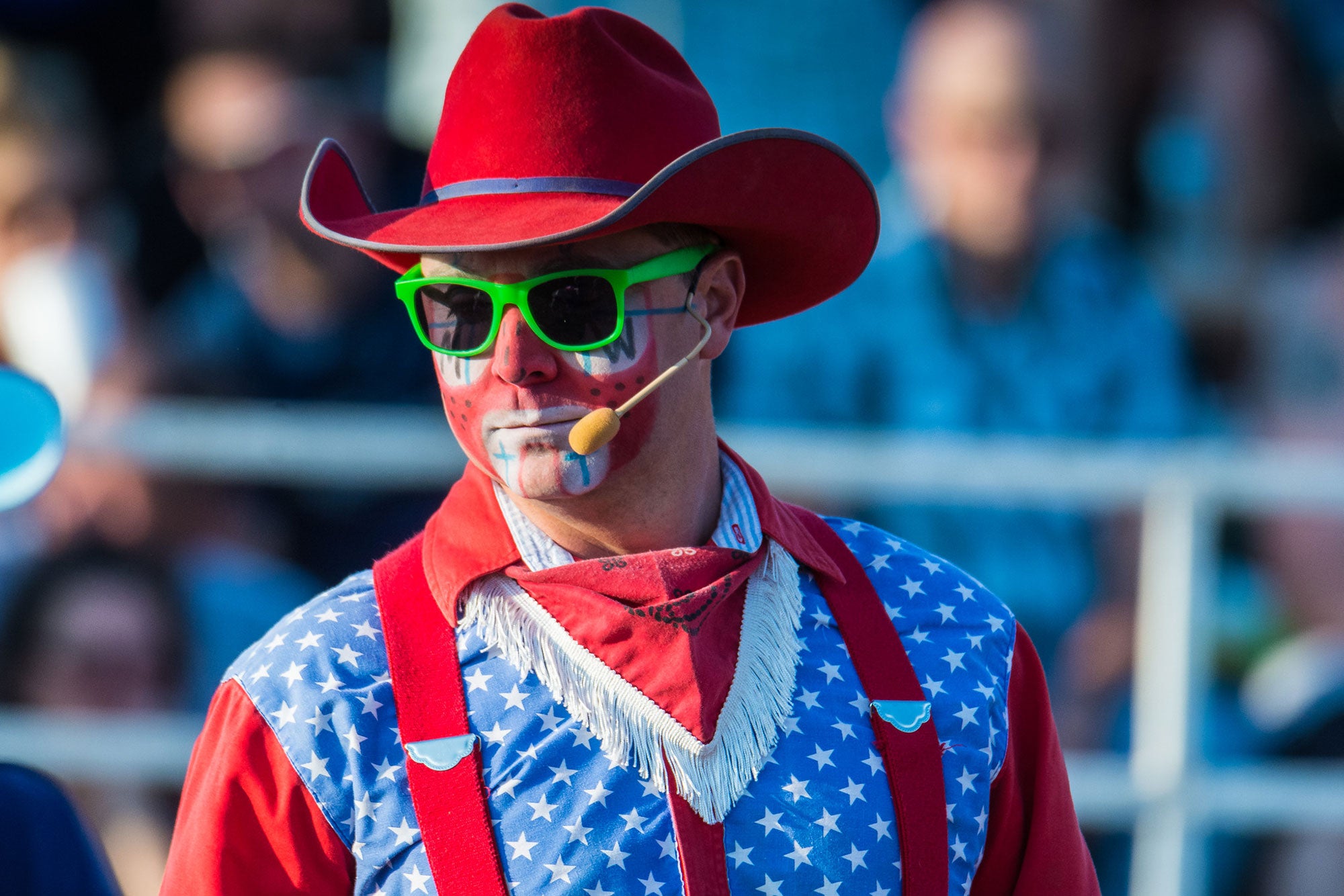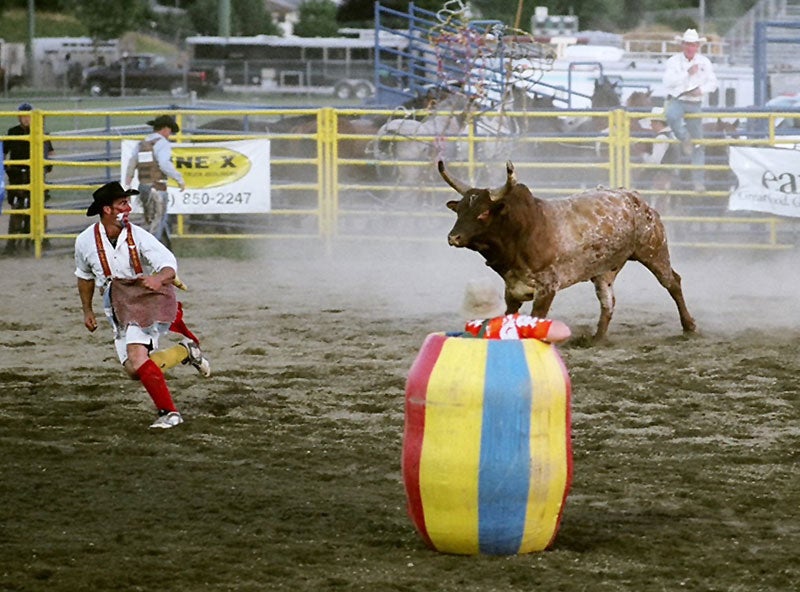In a cruel twist of fate, the job of a rodeo clown — despite the disillusioning title — is no laughing matter. There was a point in history, however, when it was.
In the early days of competitive rodeo, as it shifted from a cowboy competition on the plains to a spectator’s sport, promoters hired cowboys to entertain the crowd during transitions in events, or in lulls in the performance necessary to fix a fence or remove a wounded contestant. During these slow spots, the crowd would often lose their interest and leave the stands. As a solution to their disinterest, it was decided to pay a cowboy to entertain the crowd and provide a distraction when action was slow.
Similar to the role of a court jester or an actual clown, the rodeo clown’s original assignment was a fairly safe one: simply entertain the crowd, prevent boredom, and keep the spectators engaged during the transition of events.

In the early 1900s, the role of the cowboy comedian was to use slapstick comedy routines while wearing oversized, baggy clothes and face painting, much like circus clowns. Soon, rodeo clowning became an official occupation in its own right, as these cowboys would travel from rodeo to rodeo telling jokes, wearing costumes, and creating acts specifically to entertain rodeo-goers during slow moments.
In the 1920s and ’30s, bull riding came into vogue. With it being too difficult for a pickup rider to come in close with his horse to get a rider off of a bull, the best form of protection for a fallen cowboy was someone to distract the irate bull. This job eventually fell to the rodeo clown. In addition to providing entertainment, the clown was now responsible for using quick reflexes to lure the bull away from the fallen rider while still interjecting humor to keep the crowd distracted. It wasn’t long before the job of keeping the bull from the rider became one of the rodeo clown’s primary responsibilities, and over time the name rodeo clown and bullfighter began to be used interchangeably.
In today’s rodeo, it is not uncommon to see barrels used in the arena by rodeo clowns or bullfighters in order to tease the bull, amuse the crowd, and stay safe. The first use of the barrel is attributed to Jasbo Fulkerson, who felt he’d been run over by enough angry bulls in his life and decided to use a wooden barrel reinforced with old car tire casings as a prop during his act in the 1930s. The initiation of barrels into the rodeo brought with it a new title for the rodeo clown-turned-bullfighters: barrelmen.

Bullfighting became an art form of it’s own in the 1970s. As bulls got faster and bucked harder, the term bullfighter began to be used more frequently than that of rodeo clown, because of the risks undertaken by those in the profession. With honed skills, expert reflexes, and a willingness to always put the cowboy’s safety over his own, the focus of the role zoned in on the bullfighting component, in many cases leaving the comedy side of rodeo clowns in the dust.
While all three terms — rodeo clown, bullfighter, and barrelmen — are often used interchangeably, it is most often the size of the rodeo that determines whether or not those roles coexist within one person or are divvied out to different individuals.
At larger rodeos, the job is often split between rodeo clowns and barrelmen as well as bullfighters. Some barrelmen provide both comedy and support to bullfighters, but the job of a bullfighter is generally distinct from that of the clown. The clown’s job remains to keep the crowd entertained, while the barrelman often works alongside bullfighters keeping bulls distracted from fallen riders. In smaller venues, the role of a rodeo clown would likely be split between that of comedian and bullfighter.

While some bullfighters still wear clown makeup and may also provide traditional clowning entertainment for the crowd between rodeo events, many modern bullfighters no longer dress as true clowns. Rob Smets, a Professional Bull Riders (PBR) bullfighter, led the way in swapping out typical rodeo clown attire for a sport jersey and shorts advertising sponsors’ logos in the early 2000s. Today, the stereotypical rodeo clown attire often has given way to resembling a tackily dressed athlete.
Even though their outfits have evolved over the years, bullfighters do tend to still wear baggy or bright clothes alongside flashy accessories to get the bulls’ attention. Their one job remains to do all that is in their power to distract and attract the angry bull away from the fallen rider. In order to do so, the bullfighter makes himself the target of the bull to spare the cowboy.
In his narrative, My Short Unhappy Life As a Rodeo Clown, featured in Texas Monthly, John Spong expounds upon the one thing his teacher, acclaimed bullfighter Leon Coffee, continuously conveyed to him: “‘A clown never leads the bull back to the rider. When the bull rider or your partner is in trouble — when he has been hooked and is down or when he’s backed up to the wall — your job is to “capture” the bull, or get him to fix on you.’”
The duty of protecting the cowboy in the arena is so strong that Coffee actually advised Spong to come between the cowboy and the bull — so close that it was possible to slap him on his head if necessary to make sure you had his attention.
According to Coffee, “What you absolutely do not do … is lead the charging bull back to where the cowboy is stranded. Least of all if he’s near the wall. Get the bull out in the middle of the arena, where he can stomp his two thousand pounds of rampage and menace into dirt rather than bones. Let him wave those horns like baseball bats in the air, not into somebody’s kidney. Remember the mantra: the bull rider, your partner, yourself.”

With such a risky job, it should come as no surprise that clowns or bullfighters wear protective padding under their oversized outfits. Yet, that doesn’t provide any guarantee from injury. For the bullfighter, it’s not a matter of if, but when and to what degree he sustains injuries. For many, those injuries include concussions and broken bones of all types as well as lacerations and punctures from the bull’s horns.
Despite the danger, and regardless of what title they go by, one thing is certain: Today’s rodeo clowns, barrelmen, or bullfighters can be found dressing up in baggy clothes, putting together comedic acts, and protecting fallen cowboys at rodeos all over the country.
Katie Murray is a lifelong promoter of agriculture and lover of good stories. She enjoys communicating the story of agriculture and of the people behind our industry.



